- Markforged Onyx Filament Review & Alternatives [2024] - December 11, 2024
- 17 Best Professional 3D Printers: Commercial, Desktop, & Industrial [2024] - December 10, 2024
- Best 3D Printers (Industrial, Desktop, & More) [2024 Guide] - July 20, 2024
In 3D printing, the choice of filament is as important as the design itself. 3D printers use filaments to bring objects from digital blueprints into tangible reality. They come in various types, each offering unique properties that affect the texture, strength, and flexibility of the printed items.
Whether you are 3D printing prototypes, household items, artistic sculptures, or 3D printing car parts for automobiles, the right 3D printer filament can make all the difference.
This review explores the top 3D printer filaments on the market, showing their applications, benefits, and how to select the best option for your specific needs.
What is 3D printer filament?
3D printer filament comes in the form of a thin strand of thermoplastic material, which is melted and extruded through a heated printer nozzle to build objects layer by layer. The filament allows for high precision in creating three-dimensional objects based on digital models and is available in various compositions to suit different printing needs and finish characteristics.
Each filament type offers distinct properties such as strength, flexibility, and thermal resistance, making them suitable for various applications in industries ranging from manufacturing to 3D printing prototypes.
Types of 3D Printer Filament
Let’s take a look at some different 3D printer filaments.
1. PLA
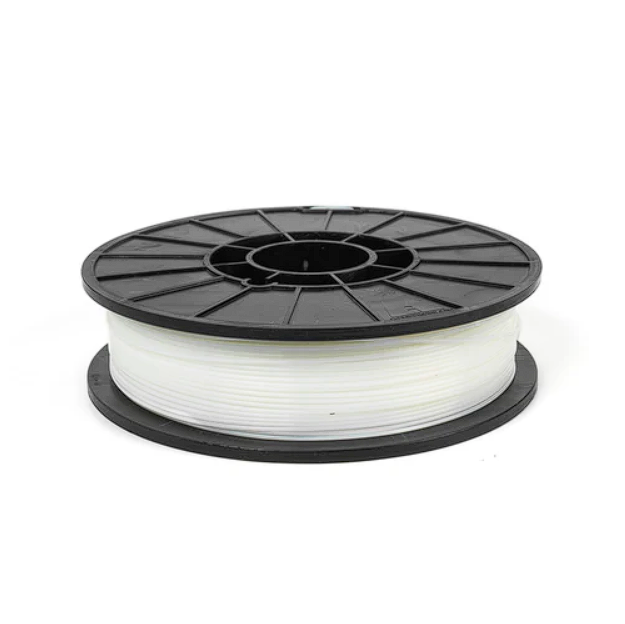
Polylactic acid (PLA) is a thermoplastic monomer made from plant-based organic sources like fermented plant starch, making it a biodegradable and environmentally friendly filament option. PLA has a relatively low melting point and usable temperatures between 180 and 230 degrees Celsius.
Although this filament has good tensile strength and stiffness, it is brittle and has poor UV resistance. However, it is generally easy to 3D print with, dimensionally stable, and does not require a heated enclosure.
Additionally, PLA does not warp easily during printing, is food-safe, and isn’t soluble in water. As a result, PLA is great for making basic prototypes using custom 3D printing and low-stress parts. It is also often used as the base material for other composite materials.
Filament Properties & Characteristics:
- Soluble in solvents like ethyl acetate, methyl ethyl ketone, tetrahydrofuran, and caustic soda
- Low heat resistance but can withstand temperatures of 55 degrees Celsius
- High surface energy
- Bio-degradable in industrial compost environments
- Available in different color options
- Comparatively low impact strength
- Works with low extrusion temperatures
2. Tough Pro PLA+
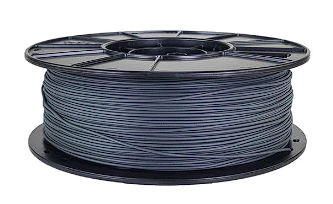
The Tough Pro PLA+ is the best type of filament to use for demanding projects that require materials with exceptional strength. Manufactured in the US from genuine NatureWorks 3D870 Ingeo PLA, Tough Pro PLA+ has a higher impact strength than standard ABS and PLA, with its heat resistance rivaling that of ABS.
Although a sustainably sourced bioplastic with an exceptional eco-profile, the Tough Pro PLA+ boasts 8.8x the impact toughness of standard PLAs all while maintaining the ease-of-printing of PLA.
Filament Properties & Characteristics:
- 8.8x the impact strength of PLA
- Recommended printing temperature of 220-240°C
- Recommended bed temperature of 0-60°C
- PEI, heated bare glass, blue painters tape, BuildTak, and WhamBam are recommended bed surfaces
- Recommended print speed of 60-250 mm/s
3. PEEK
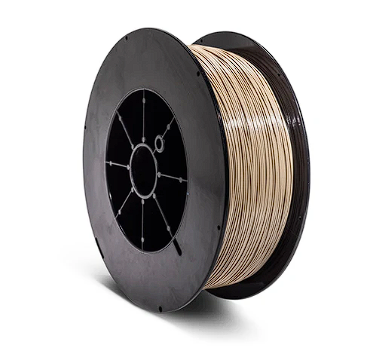
Polyether Ether Ketone (PEEK) belongs to the polyaryletherketone (PAEK) family. It is a semicrystalline thermoplastic with exceptional mechanical, chemical, and thermal resistance properties. Due to these properties, this material has been regarded as one of the highest-performing engineering-grade thermoplastics in the world for years. It is even used as a substitute for certain metals in metal 3D printing because of its strength-to-weight ratio.
PEEK has an excellent heat deflection temperature of about 156 degrees Celsius and a high melting point of about 343 degrees Celsius. It has a very high tensile strength and is equally highly resistant to chemicals, solvents, and even hydrolysis. Because of these robust properties, PEEK is used to create 3D-printed tools used in the aerospace, automotive, and oil and gas industries.
Filament Properties & Characteristics:
- Semi-crystalline material that is typically opaque
- Melting point of 343 degrees Celsius
- Continuous use temperature of 250 degrees Celsius
- Inherently flame retardant with low FST (Flame, Smoke, Toxicity)
- Good impact resistance and toughness
- Moderately resistant to weathering
- Low friction coefficient
- Exceptionally resistant to hydrolysis in hot water and insoluble to all common solvents at room temperature except for strong acids like 95% sulphuric acid
4. PEKK
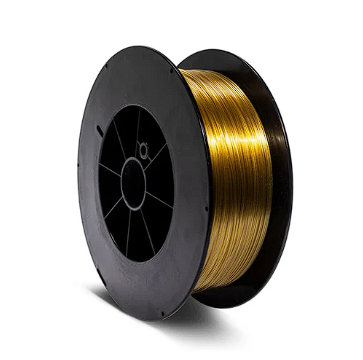
PolyEtherKetoneKetone (PEKK) is another extremely high-performing polymer in the PAEK family with superior mechanical and thermal properties. It is considered substantially easier to print than PEEK due to its lower crystallization rate, which allows it to be processed more like an amorphous material while retaining the benefits of a high-performance polymer.
This attribute simplifies the 3D printing process, making PEKK more compatible with many additive manufacturing processes like FDM and selective laser sintering (SLS).
Filament Properties & Characteristics:
- An extrusion temperature of between 340 and 360 degrees Celsius during 3D printing
- Heat deflection temperature of about 250 degrees Celsius
- Good shock absorbance
- Inherently flame-resistant with low smoke generation and low outgassing
- High resistance to a long list of organic and inorganic chemicals
- Modest print conditions with minimal warping
5. PETG
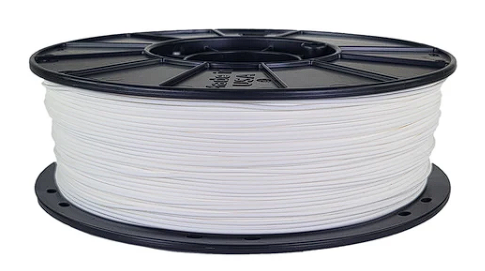
Polyethylene Terephthalate Glycol (PETG) is a synthetic thermoplastic polyester with significant chemical resistance and durability. It is a tough, hardy, and flexible material that makes it a great alternative to PLA as it shares many of its strengths. PETG 3D printing filament has good light adhesion, and impressive layer adhesion, and is recyclable, making it easy to apply in 3D printing processes.
PETG is used to create prototypes and large functional models using large 3D printers across various industries, including food containers, bottles, electronic insulators, and even lamp shades.
Filament Properties & Characteristics:
- High chemical and impact resistance
- Good thermal stability with extrusion temperature between 220-260 degrees Celsius
- Prints easily with excellent layer adhesion
- Odorless while printing
- Non-toxic and food-safe
- Low fragility and good flexibility
- High air moisture absorbency
- Low shrinkage
6. PCTG
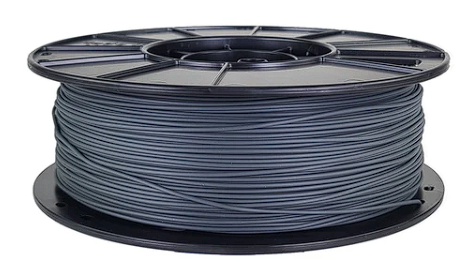
PCTG is a polyester filament with all the qualities of PETG combined with excellent clarity, chemical resistance, and impact resistance. It has high ductility, low shrinkage, excellent dimensional stability, and moisture absorption that is 3 times lower than PETG.
PCTG is great for manufacturers looking for an affordable, easy-to-print filament for functional parts to cut 3D printing costs. It is used in various applications, including for making spare parts in the automotive industry and accessories in the sports industry.
Filament Properties & Characteristics:
- High optical transparency
- Dimensional and low shrinkage makes it easy to print
- BPA-free and food-safe
- Does not require a heated chamber during printing
- Higher chemical resistance than ABS and PETG
- Good mechanical strength and toughness.
7. PA
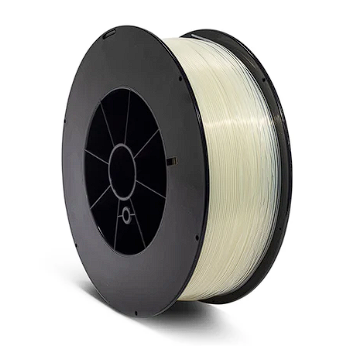
Polyamide (PA) also known as nylon, is characterized by great resistance to impact, high flexibility when thinly printed, and high inter-layer adhesion that makes it easy to print with. Its high mechanical strength means it is suited for the most demanding technical applications and is usually used to make items like bearings, plugs, gears, and other strong and flexible parts or those demanding high fatigue endurance.
Filament Properties & Characteristics:
- Semi-crystalline structure
- High impact resistance
- High abrasion resistance
- Low coefficient of friction
- Thermal resistance of up to 120 degrees Celsius
- Highly hygroscopic material
8. TPU
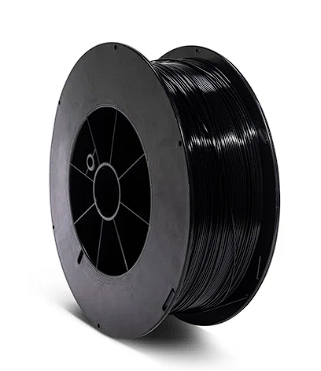
Thermoplastic Polyurethane (TPU) is an elastomer characterized by robust elasticity and flexibility. It is a resilient, rubber-like filament with high wear and tear resistance, making it suitable for applications requiring impact absorption.
TPU is resistant to abrasions, oils, greases, lubricants, and chemicals. It is equally resistant to low temperatures, warping, and tearing. As a result, TPU is typically used in footwear, raincoats, wheels, and in other applications that require a durable material in industries such as automotive.
Filament Properties & Characteristics:
- High elasticity and resilience
- Low-temperature performance
- Good compression set
- Resistance to abrasion and tear
- Weather resistance
- Impressive impact resistance
9. HTN
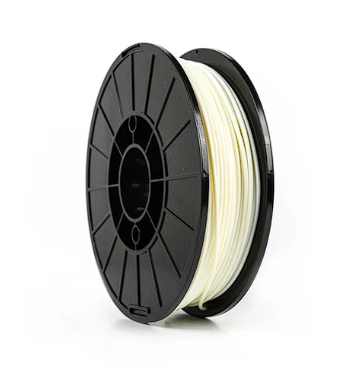
High-temperature nylon (HTN) by Essentium is a member of the PA filament family. It has more advanced properties than standard PA filaments, making it ideal for use in combustible and explosive atmospheres.
HTN is a tough material with high strength, improved wear resistance, and excellent chemical resistance. It is easy to print, does not warp easily during production, and has excellent slow moisture absorption. HTN can be used to make electrical housings, low-speed moving parts, and jigs and fixtures.
Filament Properties & Characteristics:
- Better heat deflection temperature than standard PA (Nylon)
- Better printability than ABS and PA
- Wear resistant
- Excellent chemical and solvent resistance
- High toughness and strength.
10. PP
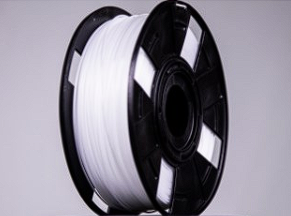
Polypropylene (PP) is a semi-crystalline homopolymer with a high level of flexibility. Although elastic and lightweight, PP filament has excellent toughness. Additionally, PP has excellent fatigue resistance that makes it bendable without breaking, good chemical resistance, and good interlayer bonding.
While it has unique properties, non-fiber-reinforced PP can be difficult to print with because it warps easily.
Filament Properties & Characteristics:
- Melting point of 130 degrees Celsius
- Heat deflection temperature of 64.1 degrees Celsius
- Ability to resist impact loading
- Can withstand millions of stress cycles without shattering
- Chemical resistance to a wide range of acids, bases, and solvents at room temperature
11. PPS
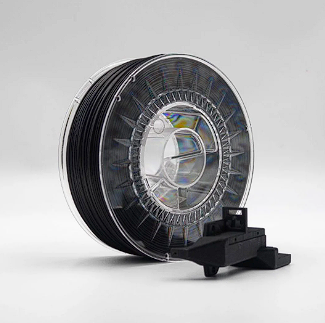
Polyphenylene Sulfide (PPS) is a high-performance polymer with excellent chemical resistance, mechanical properties, and thermal properties. PPS is flame-retardant and self-extinguishing with exceptional mechanical strength, making it suitable for use in demanding industries like automotive and chemical processing. In addition, PPS has exceptional dimensional stability and electrical insulation properties and is completely insoluble in any solvent below 200 degrees Celsius.
Filament Properties & Characteristics:
- Semi-crystalline, rigid, and opaque
- High melting point of 280 degrees Celsius
- Exceptional mechanical strength and dimensional stability
- Electrical insulation properties
- Resistance to high temperature, flame, and chemical
- Easy to process
- Low water absorption
- Maintains chemical resistance and tensile strength above 200 degrees Celsius
12. ABS
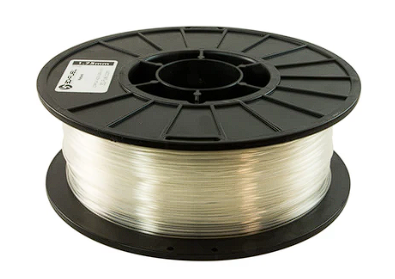
Acrylonitrile Butadiene Styrene (ABS) is highly flexible and has excellent moldability and strength, making it applicable across several industries in the production of structures such as automotive parts. Objects printed with ABS filaments are typically tough, durable, non-toxic, and can withstand considerable impact.
However, parts printed with ABS are prone to warping. The filament also releases foul-smelling volatile organic compounds (VOCs) when processed, a problem that can make the printing process less enjoyable. Lastly, ABS becomes discolored and brittle when exposed to prolonged UV radiation, making it less suitable for use outdoors.
Filament Properties & Characteristics:
- Print temperature between 210-250 degrees Celsius
- High strength and durability
- Medium flexibility and ease of use
- Possibility of warping during printing
- Soluble in esters, ketones, and acetone
- Resistance to corrosive chemicals and physical impacts
- Mendable by sanding, drilling, or machining
- Can be welded, plated, painted, and joined using adhesives
- Resistance to abrasion
13. PEI 9085
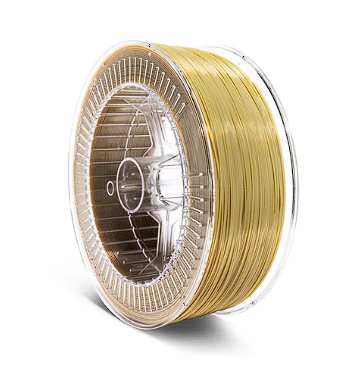
PEI 9085 Filament is a high-temperature printing polymer with excellent flame, smoke, and toxicity (FST) characteristics. It is a highly durable thermoplastic with a high strength-to-weight ratio and a comparable impact strength to metals like aluminum.
PEI 9085 is inherently flame-retardant with resistance to a range of chemicals that include alcohol, automotive fluids, and aqueous solutions. These properties make PEI 9085 ideal for use in aerospace and automotive where it is used to make durable lightweight parts.
Filament Properties & Characteristics:
- High strength-to-weight ratio
- Heat deflection temperature of 167 degrees Celsius
- FST-compliant and certified for aircraft compounds
- Inherently flame retardant
- Chemical resistant
- Requires heated enclosure during printing
14. Duratem™
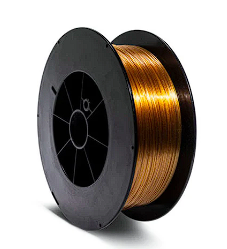
Duratem by Essentium is a filament made of polyetherimide, polycarbonate, and siloxane, combining the properties of all three materials to provide advanced features in one filament. It has an impact strength of about 30 kilojoules per square meter and can withstand temperatures as high as 150 degrees Celsius and as low as -30 degrees Celsius.
Due to its ability to withstand high force and a wide range of temperatures, Duratem is suitable for use in demanding industries like aerospace, automotive, and industrial sectors. Duratem is about 9 times as strong as PEKK, making it one of the strongest filaments in the market today.
Filament Properties & Characteristics:
- High temperature resistance up to 150 degrees Celsius and cold temperature resistance up to -30 degrees Celsius
- Low corrosivity
- High dimensional stability and thin-wall stability
- Low moisture absorption
- Passes test for flammability, heat release, smoke density, and toxicity
- Contains a non-halogenated flame retardant for health and safety
15. Altitude™

Essentium Altitude is a high-performance polycarbonate filament material designed for outdoor use. It is regarded as the first 3D printing filament to withstand cold temperatures as low as -60 degrees Celsius without cracking or falling apart. This property makes it especially suitable for creating models suitable for use at high altitudes or in extremely cold temperatures.
Altitude has several advanced mechanical features that range from flame resistance to ultraviolet resistance, making it a great option for use in industries such as aerospace and construction. Altitude can be used on several open-source 3D printers, including the Essentium High-Speed Extrusion (HSE) printers.
Filament Properties & Characteristics:
- High temperature resistance and extreme cold resistance
- Impact resistance
- Flame retardant and UV-resistant
- Excellent for outdoor use
All About 3D Printer Filament
Before choosing a 3D printer filament to implement in your 3D printing manufacturing processes, it is important to understand the following key aspects:
Where to buy 3D printer filament
You can purchase 3D printer filament from various sources, including online retailers like Nexa3D’s Essentium, which offers a catalog of high-performance filaments, or dealers, such as local stores in your area.
How much does 3D printer filament cost?
The cost of a 3D printer filament varies with the brand, quality, and type of the printer filament. They can cost as little as $20 or as much as upwards of $60 per roll. It is important to know that specialty filaments may be more expensive.
What is 3D printer filament made out of?
3D printer filament is often made of materials such as PLA, PETG, ABS, and PP. Each material offers unique characteristics and properties in strength, flexibility, and printing ease.
How to store 3D printer filament
To store your 3D printer filament, keep it in a cool, dry place away from sunlight. You may also use airtight containers or vacuum seals to prevent moisture absorption and preserve the filament.
How to dry 3D printer filament
To dry a 3D printer filament, use a filament dryer or place it in an oven for four to six hours at a suitable temperature. Suitable target temperatures for some of the most common filaments are PLA 40-45 °C, ABS ~80 °C, and Nylon ~80 °C. You can also use a food dehydrator.
What is the strongest 3D printing filament?
Polycarbonate is one of the strongest 3D printing filaments, recognized for its exceptional strength and ability to withstand significant forces, impact, and temperature. However, this filament can be tricky to print as it is prone to warping and requires an enclosed 3D printer with proper storage to prevent moisture absorption.
Other strong 3D printing filament options include 9085, AltitudeTM, Duratem, PA (Nylon), and PEEK.
How long does 3D printer filament last?
The shelf life of 3D printer filament depends on storage conditions. When stored properly, filament can last anywhere from 1 to 2 years. However, certain filaments can last 3 to 5 years without significant degradation.
How to remove filament from 3D printer
To remove the filament from a 3D printer, you need to heat the extruder to the filament’s melting temperature. Afterward, squeeze the extruder lever to release the filament’s grip, manually retract it, and gently pull it out once it softens.
How to replace 3D printer filament
To replace a 3D printer filament, you will need to unload the old spool currently in use, load the new spool in the spool tray, and adjust printer settings to accommodate the new filament.
How much filament does a 3D printer use?
The amount of filament that a 3D printer uses depends on factors such as the printer’s size, the print’s infill percentage, and project volume.
Buy the Best 3D Printer Filament
3D printing filaments offer a diverse range of materials and capabilities that can be harnessed through the power of 3D printing. From the reliable and easy-to-use PLA to the more advanced HTN and specialty AltitudeTM, there are various filament options to suit the needs of hobbyists, professionals, manufacturers, and 3D printing services alike across all industries.
While there are indeed impressive filament options in the market today, choosing a filament that offers exceptional mechanical and physical properties is critical to the success of any printing process.
For those seeking top-notch mechanical and physical properties, Essentium filaments stand out as premier choices. Whether crafting functional prototypes or robust end-product models, Essentium offers unmatched quality and reliability to bring your creative visions to life seamlessly.
Ready to work with the best filaments in the market?
